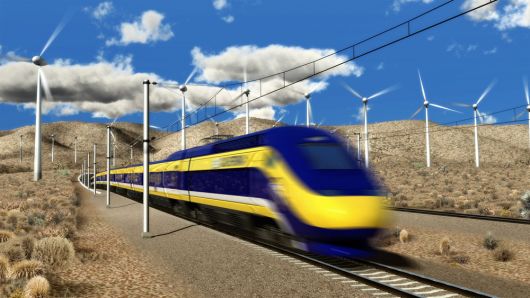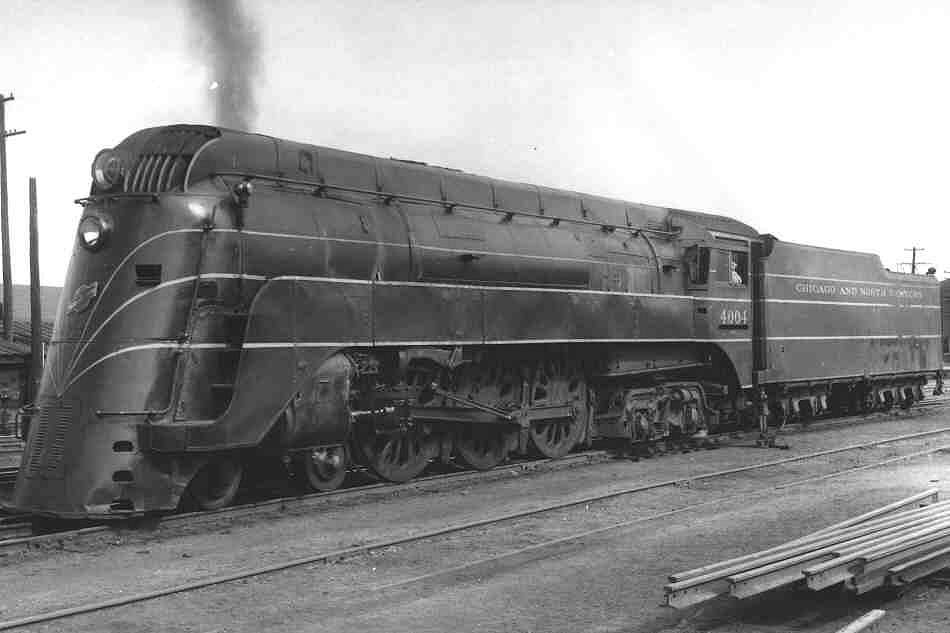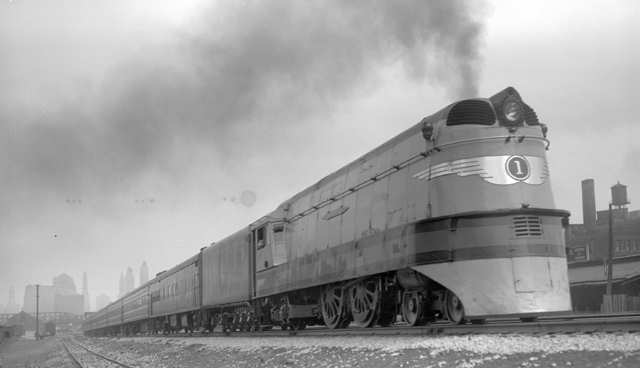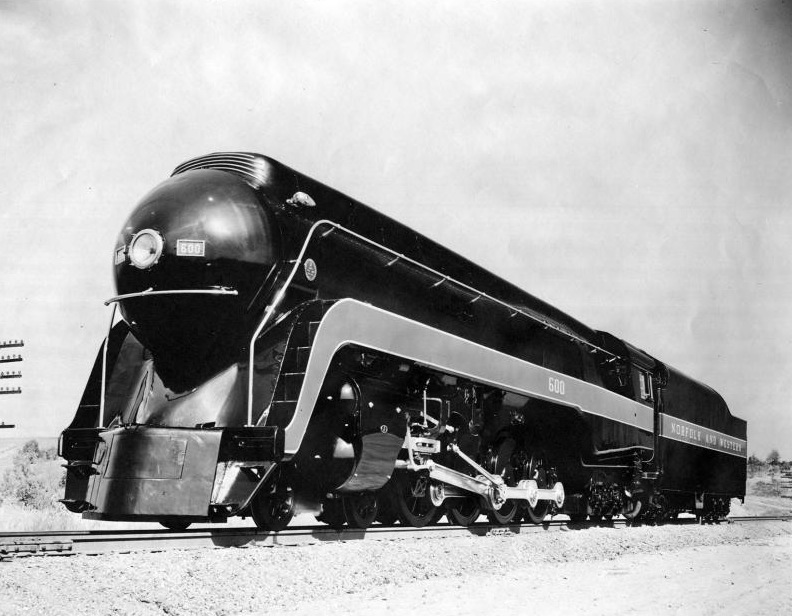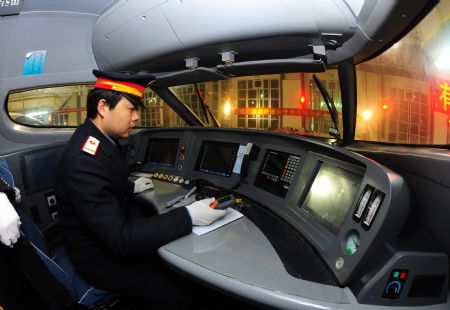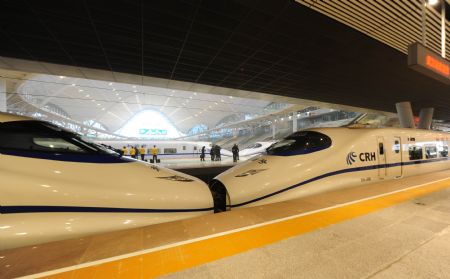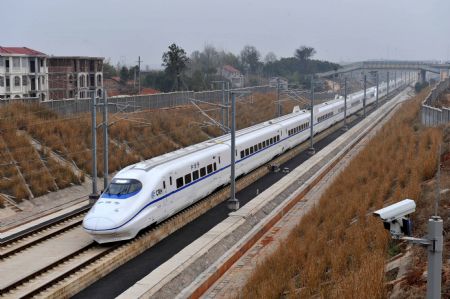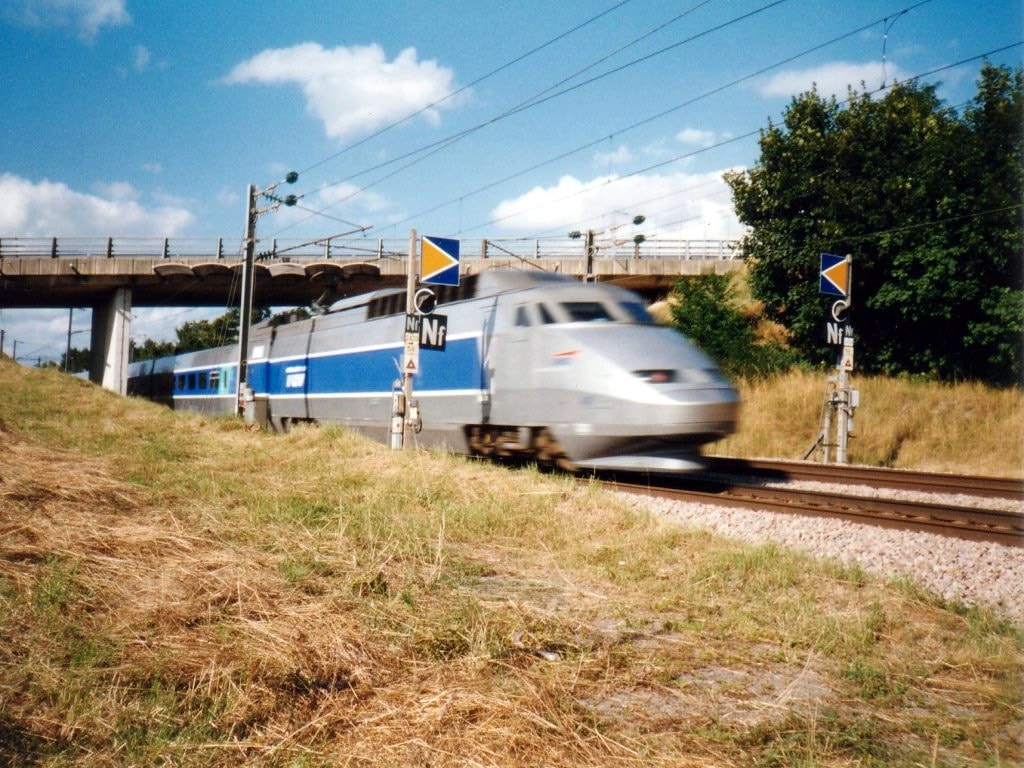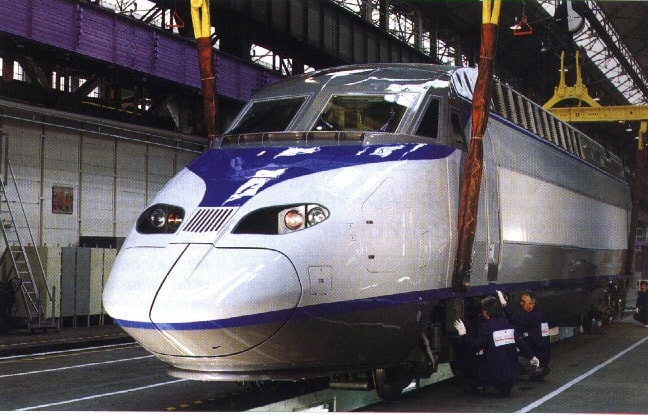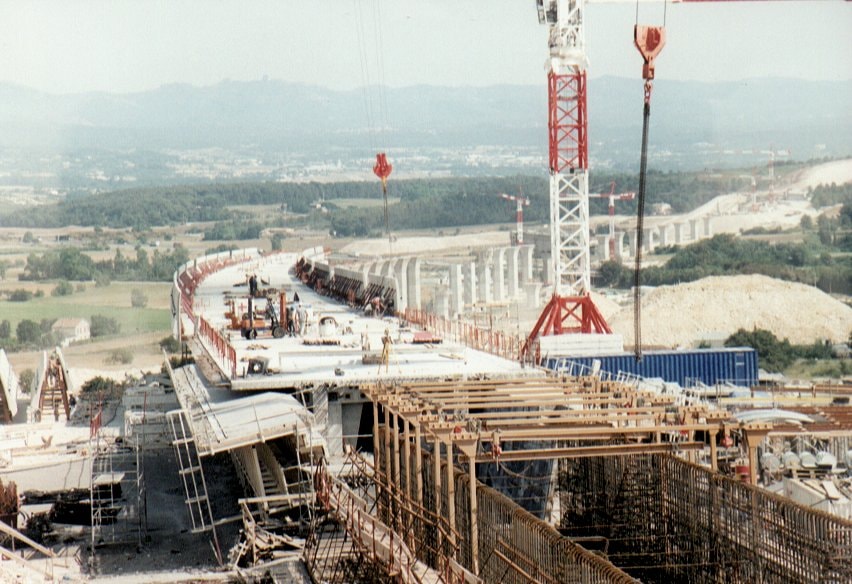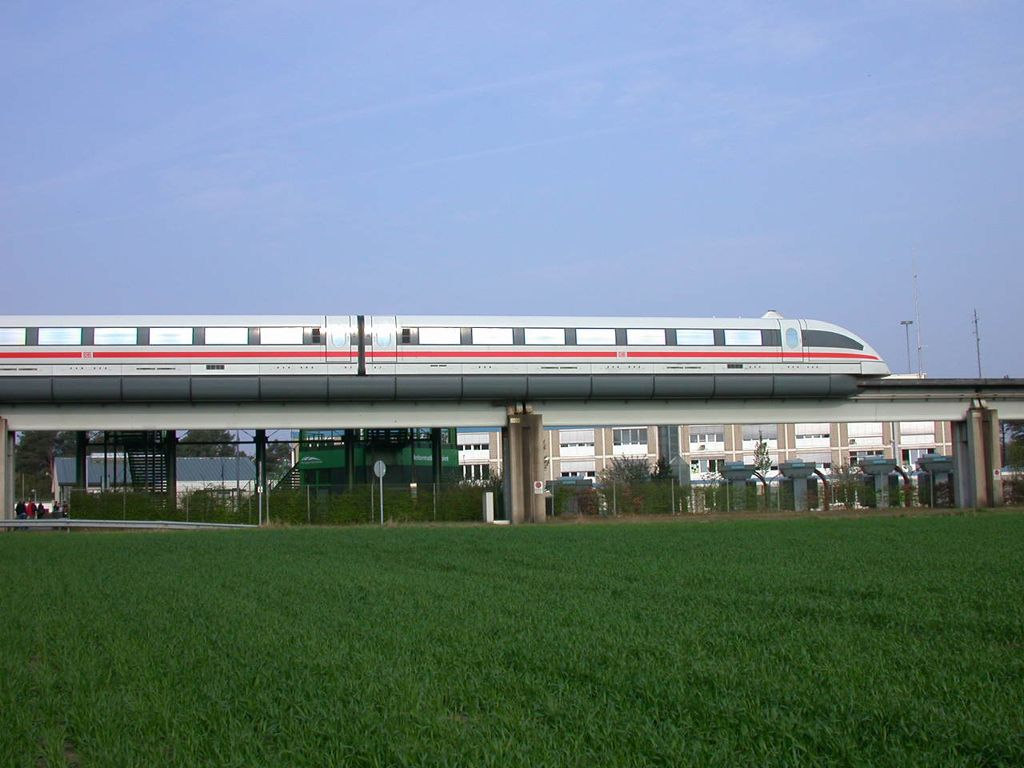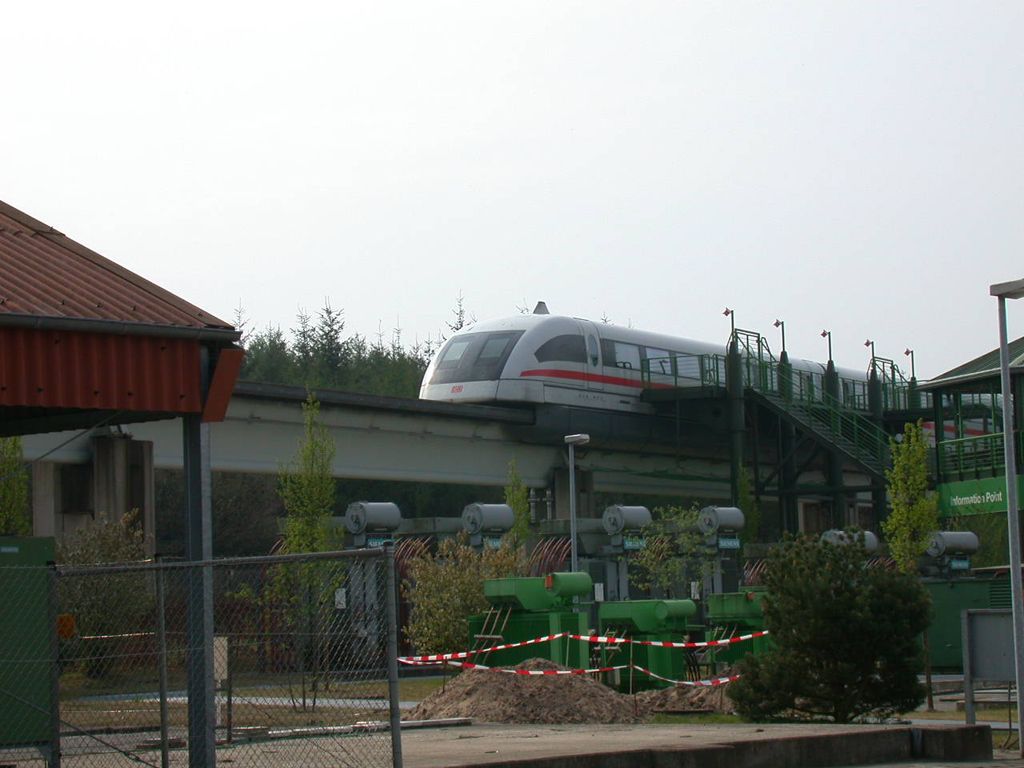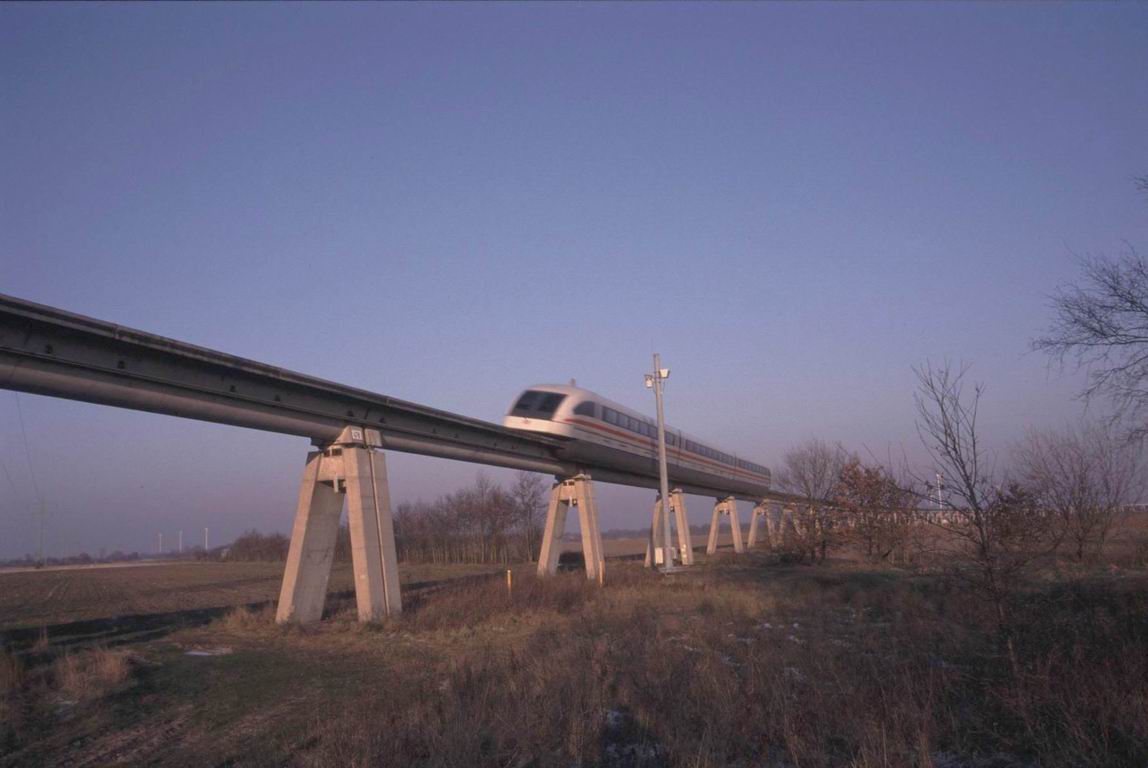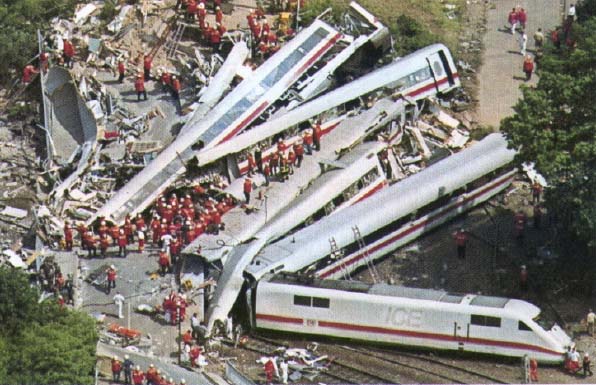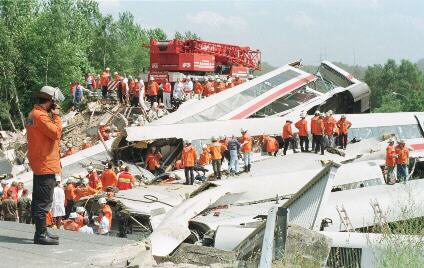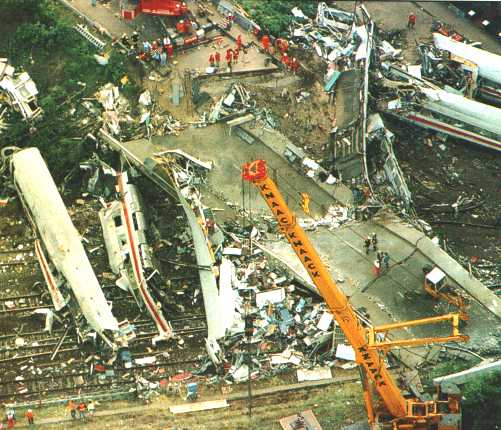Railways are the first means of public transportation and ever since the first train left the station, authorities around the world, together with companies and transportation departments, have strived to raise efficiency and costs. And these two aspects were indeed improved a lot but as time passed by efficiency easily became speed, which is actually the essence of public transportation: getting you from point A to point B in the shortest possible time.
In the context of railways, however, the term of speed evolved beyond what we usually expect when we refer to a moving vehicle, with today's trains capable of achieving insanely high speeds, while ensuring a decent amount of comfort without putting the passengers' lives at risk at all.
Without spending too much time on history topics, we'll examine the evolution of high-speed trains, the way they managed to influence public transportation and what to expect from the future.
HISTORY - THE WAY THEY WERE BORN
THE RAILWAY - FROM SKETCH TO REALITY
TGV - HIGH-SPEED FRENCH FLAVOUR
MAGLEV - A GLIMPSE INTO THE FUTURE
ACCIDENTS - WHEN SOMETHING GOES WRONG
HISTORY
It was a time when passenger cars weren't exactly the most appropriated means of transportation and buying such a “luxurious thing” was only a whim accessible to affluent people. That was the era when trains were the primary form of land transportation.
It all started with steam trains and, although this may sound impossible, they were capable of speeds in excess of 160 km/h (99 mph). Streamlined trains, especially used in Europe and United States for high speed routes, could achieve an average speed of 130 km/h (81 mph) but, taking into account that such a speed was conditioned by a number of factors such as the distance between stations and railway health, their use was fairly limited.
The streamliners laid the foundation of high-speed trains but the first glimpse into what had to become the first high speed rail came from Japan in 1957. A major railway company based in Tokyo, Japan and called Odakyu Electric Railway presented the Romancecar 3000 SE, a narrow gauge train that broke the world speed record with a top speed of 145 km/h (90 mph). This was the first proof that train makers could develop a standard gauge train that could achieve even greater speeds. It was only a matter of time...
Efforts in this particular efforts continued as time passed by, but in 1959 Japanese engineers started work on an enthusiastic project that finally gave birth to the first real high-speed railway. Completed in 1964, the TMkaidM Shinkansen line connected Tokyo and Shin-Lsaka. The Japanese prepared a grand opening for the project, as the debut took place in the same time with the 1964 Summer Olympics in Tokyo, so the whole world could notice Japan's surprising achievements.
Now that the line was ready, Japanese authorities had to find a company that would develop a high-speed train to benefit from all those “revolutionary” technologies. Just as expected, the solution came from a Japanese company as well, by the name of Kawasaki Heavy Industries, which built the so-called 0 Series Shinkansen, a passenger train that could reach 210 km/h (130 mph). Developments continued, so speeds kept increasing over time, with a new record established in 1963 when the train achieved 256 km/h (159 mph).
The Japanese were the first to start work on high-speed trains but other nations across the world scratched their heads and started working on their very own versions. The next in line to present its achievements was Germany in 1965 – during the International Transport Fair in Munich - the DB Class 103, a series of electric locomotives, reached a top speed of 200 km/h on a route between Munich and Augsburg. It was the first sign that high-speed trains are possible on the Old Continent as well, so soon after that, the SNCF Class BB 9200 locomotives hit the railway on newly-built French lines.
THE RAILWAY
When talking about a high-speed train, we actually refer to two interconnected things: the train per se and the railway. Obviously, the train is the main character in the play but the railway and all the stuff underneath it have the sole job to keep the vehicle on the ground. And imagine, doing this at over 400 km/h with hundreds of passengers onboard is vital.
Overall, the two most important problems when dealing with a high-speed railway are the costs and the location, as the area that will connect the two defined points must comply with a series of factors. For instance, engineers across the world struggled to design as many straight lines as possible as a curve, no matter how tight it is, reduces speed and raises the risk of accidents.
Specifically however, the most difficult part is to develop a railway that would have absolutely no junctions and would include as fewer stations as possible. Curve successions and traffic crossings are once again a thing to avoid but engineers pretty much managed to find a solution to this: elevated railways or tunnels.
The cost of such a project is obviously depending on a number of factors, so it's hard to release some estimates. History however proves that it could go around several millions Euros per kilometer. In France for example, the LGV Est - which connected Paris and Strasbourg - cost 10 million Euros per kilometer. In order to reduce the overall investment to minimum, local constructors turned to less-expensive infrastructure.
Japan on the other hand is probably owning the most expensive high-speed railways in the world, as local lines are a real state-of-the-art creation. Not only that the infrastructure is outstanding and trains are thus capable of achieving insane speeds, but every route is closely monitored by several operators, there are no traffic crossings and several elevated sectors to avoid reducing speed.
As for trains, the technology installed “under the hood” varies by country and/or manufacturer, but we're going to talk about the two most important names in this area: France's TGV and Maglev trains.
TGV
Although the origins of high-speed trains are in Japan, the French engineers managed to do a pretty good job with the creation of TGV (or Train à Grande Vitesse if you prefer). The railway is operated by VFE, a separate division belonging to SNCF (Société Nationale des Chemins de fer français), which is some kind of a French national railway branch.
As we said, Japan's grand opening of Shinkansen inspired several other governments across the world, all of them spotting the huge potential behind such a project. France was one of the countries that tried to design its very own high-speed railway, with the first idea emerging during the '60s. The government obviously brought its contribution and granted funds for the necessary technology developments.
According to the first sketches, the TGV was initially intended to employ a gas turbine-electric locomotive but, just like the automotive industry which was severely affected by the oil crisis during the '70s, French engineers altered the plan a little bit. Although the first prototype, known as TGV 001, was indeed equipped with a gas turbine, the whole project then turned into an electric means of transportation, with power to be provided by nuclear power stations across the country.
Apart from the fact that the prototype we mentioned never reached production, it managed however to remain in history. The train reached a maximum speed of 318 km/h (198 mph), which is basically the top speed of non-electric trains.
Developments in the electric field went pretty good and the first “green” prototype emerged in 1974. Codenamed Zebulon, the train was using the latest in engine, suspension and braking areas. After more than 1 million kilometers covered during testing sessions, the French government finally approved the project in 1976 and granted the necessary funds for the LGV Sud-Est (ligne a grande vitesse), the first high-speed line also known as LN1. The first production TGV hit the rails in on April 25, 1980, but was only opened to the public in September 1981 on a route connecting Paris and Lyon.
The beginning was extremely difficult and people were reluctant when it came to the TGV. Traveling with such a high-speed vehicle was still seen as a risky thing to do, so the railway was mostly considered an airplane alternative for people who were looking to reach a destination in a shorter time than before.
However, the government once again stepped in and encouraged people to at least try the TGV. The railway was promoted as an affordable and accessible service, faster than other means of transportation. Just as the French officials hoped to happen, people became more interested in the TGV lines, with popularity exploding in the next few years. This also attracted the attention of neighbor states that started investing money to design their very own lines and thus create longer routes connect to the French TGV's. Belgium, Netherlands and United Kingdom contributed to the expansion of the TGV, which is expected to carry its two billionth passenger sometime this year. To give you an idea an idea on how popular the TGV is, we must mention that the number of passengers who traveled with the French high-speed train in 2008 totaled 98 million.
Each of the lines are split into so-called signal blocks, each of them measuring 1500 meters. This way, the driver can notice how close he is to the upcoming stations and act accordingly. However, because the speed is too high and it's absolutely impossible to observe any sign or signal placed near the track, the locomotive “communicates” with the rails using electric pulses which collect and send data such as speed and a series of recommendations. The information is displayed on the dashboard, but separate safeguards can automatically reduce speed or even bring the train to a halt should the driver fail to act.
TGV's line is completely separated using fences and trespassing is obviously strictly prohibited. There are no junctions at the same level, as this would increase the risk of derails and every single bridge has several sensors can detect an obstacle on the track. If such a scenario occurs, the driver is notified when the train is approaching the respective bridge.
TGVs do not run during night time, so maintenance and other repairs that don't require urgent intervention are carried out during this period. The lines are reserved to TGVs but some other trains could use them as well, albeit with some restrictions.
MAGLEV
The term Maglev isn't such a novelty for us, as the technology is currently being used in several regions of the world. Also known as magnetic levitation, the system is actually the basis of a high-speed railway that employs magnets supporting both lifting and propulsion.
Although this is quite a new project, similar ideas existed in the early 1900s when German Alfre Zehden was granted US patents for a special linear motor to power trains. Developments continued over years and two new patents approved in 1937 and 1941 to Hermann Kemper for magnetic levitation trains laid the foundation for the Maglev system. The first “spoken” idea however emerged in 1968 in New York, United States when James Powell, a researcher at Brookhaven National Laboratory (BNL), said that a potential solution to the crowded traffic would be a some kind of magnetic levitation-based transportation. Soon after that, he started work on several projects to support this idea but no mass-produced version ever existed.
The solution came however from Great Britain in 1984 when country officials inaugurated a monorail track between Birmingham International Airport and Birmingham International railway station. Its features were fairly limited though: a maximum speed of 42 km/h (28 mph) plus very high maintenance costs, with the latter representing the main reason for closing it down in 1995.
At this moment, the Maglev system is implemented in several countries across the globe, including Europe, Asia and the United States. Furthermore, several governments are now lobbying for similar projects, while others have already started construction.
The most impressive implementation of the Maglev system can be found in China under the name Shanghai Maglev Train or Shanghai Transrapid. Also known as the first Maglev-based system in the world, the Chinese railway is also know for establishing the record speed of 501 km/h (311 mph).
The line was initially intended to connect the Shanghai Pudong International Airport to the city per se, with the whole distance covered in a total time of 7 minutes and 20 seconds. As a short presentation, the train needs 2 minutes to reach 350 km/h (220 mph), while going all the way up to 431 km/h (268 mph).
The Chinese system relies on Transrapid technology provided by the Germans and priced at $1.33 billion. The whole project needed two and a half years to be 100 percent completed and measures 30.5 kilometers.
INCIDENTS
Unfortunately, such a high speed leads to a growing risk of accidents which, in most cases, prove to be fatal to most of those involved. Over time, the high-speed train “industry” was affected by deadly accidents.
The Eschede train disaster, as it is being called nowadays, is surely the biggest accident ever, with fatalities counting 101 people. The incident occurred on June 3, 1998, near the village of Eschede in the Celle district of Lower Saxony, Germany.
According to official reports following the investigations, the accident was caused by one of the wheels which, in its turn, caused the train to derail. The power car passed under a bridge while the following carriages crashed, resulting in a huge impact in which 101 people were killed and 88 injured. Furthermore, a car driven on the bridge was found under the ruins and, although initial reports suggested that the train collided with the vehicle, it was later proved that the main cause of the accident was the aforementioned fatigue crack in a wheel.
The French TGV was also involved in several accidents but, curiously, no passenger has died since the train was officially offered to public use. The first accident occurred on December 14, 1992 when the TGV 920, traveling from Annecy to Paris, derailed at 270 km/h (168 mph) when entering a station. Surprisingly, no one died but some people in the station waiting for the train were injured by pieces of the derailed train.
A second accident happened on December 21, 1993. The TGV 7150 left Valenciennes with Paris as the final destination but the train derailed at 300 km/h (186 mph) at the current location of the Haute Picardie TGV station. Once again, the accident had no fatalities, but one passenger suffered minor injuries.
In the context of railways, however, the term of speed evolved beyond what we usually expect when we refer to a moving vehicle, with today's trains capable of achieving insanely high speeds, while ensuring a decent amount of comfort without putting the passengers' lives at risk at all.
Without spending too much time on history topics, we'll examine the evolution of high-speed trains, the way they managed to influence public transportation and what to expect from the future.
HISTORY - THE WAY THEY WERE BORN
THE RAILWAY - FROM SKETCH TO REALITY
TGV - HIGH-SPEED FRENCH FLAVOUR
MAGLEV - A GLIMPSE INTO THE FUTURE
ACCIDENTS - WHEN SOMETHING GOES WRONG
HISTORY
It was a time when passenger cars weren't exactly the most appropriated means of transportation and buying such a “luxurious thing” was only a whim accessible to affluent people. That was the era when trains were the primary form of land transportation.
It all started with steam trains and, although this may sound impossible, they were capable of speeds in excess of 160 km/h (99 mph). Streamlined trains, especially used in Europe and United States for high speed routes, could achieve an average speed of 130 km/h (81 mph) but, taking into account that such a speed was conditioned by a number of factors such as the distance between stations and railway health, their use was fairly limited.
The streamliners laid the foundation of high-speed trains but the first glimpse into what had to become the first high speed rail came from Japan in 1957. A major railway company based in Tokyo, Japan and called Odakyu Electric Railway presented the Romancecar 3000 SE, a narrow gauge train that broke the world speed record with a top speed of 145 km/h (90 mph). This was the first proof that train makers could develop a standard gauge train that could achieve even greater speeds. It was only a matter of time...
Efforts in this particular efforts continued as time passed by, but in 1959 Japanese engineers started work on an enthusiastic project that finally gave birth to the first real high-speed railway. Completed in 1964, the TMkaidM Shinkansen line connected Tokyo and Shin-Lsaka. The Japanese prepared a grand opening for the project, as the debut took place in the same time with the 1964 Summer Olympics in Tokyo, so the whole world could notice Japan's surprising achievements.
Now that the line was ready, Japanese authorities had to find a company that would develop a high-speed train to benefit from all those “revolutionary” technologies. Just as expected, the solution came from a Japanese company as well, by the name of Kawasaki Heavy Industries, which built the so-called 0 Series Shinkansen, a passenger train that could reach 210 km/h (130 mph). Developments continued, so speeds kept increasing over time, with a new record established in 1963 when the train achieved 256 km/h (159 mph).
The Japanese were the first to start work on high-speed trains but other nations across the world scratched their heads and started working on their very own versions. The next in line to present its achievements was Germany in 1965 – during the International Transport Fair in Munich - the DB Class 103, a series of electric locomotives, reached a top speed of 200 km/h on a route between Munich and Augsburg. It was the first sign that high-speed trains are possible on the Old Continent as well, so soon after that, the SNCF Class BB 9200 locomotives hit the railway on newly-built French lines.
THE RAILWAY
When talking about a high-speed train, we actually refer to two interconnected things: the train per se and the railway. Obviously, the train is the main character in the play but the railway and all the stuff underneath it have the sole job to keep the vehicle on the ground. And imagine, doing this at over 400 km/h with hundreds of passengers onboard is vital.
Overall, the two most important problems when dealing with a high-speed railway are the costs and the location, as the area that will connect the two defined points must comply with a series of factors. For instance, engineers across the world struggled to design as many straight lines as possible as a curve, no matter how tight it is, reduces speed and raises the risk of accidents.
Specifically however, the most difficult part is to develop a railway that would have absolutely no junctions and would include as fewer stations as possible. Curve successions and traffic crossings are once again a thing to avoid but engineers pretty much managed to find a solution to this: elevated railways or tunnels.
The cost of such a project is obviously depending on a number of factors, so it's hard to release some estimates. History however proves that it could go around several millions Euros per kilometer. In France for example, the LGV Est - which connected Paris and Strasbourg - cost 10 million Euros per kilometer. In order to reduce the overall investment to minimum, local constructors turned to less-expensive infrastructure.
Japan on the other hand is probably owning the most expensive high-speed railways in the world, as local lines are a real state-of-the-art creation. Not only that the infrastructure is outstanding and trains are thus capable of achieving insane speeds, but every route is closely monitored by several operators, there are no traffic crossings and several elevated sectors to avoid reducing speed.
As for trains, the technology installed “under the hood” varies by country and/or manufacturer, but we're going to talk about the two most important names in this area: France's TGV and Maglev trains.
TGV
Although the origins of high-speed trains are in Japan, the French engineers managed to do a pretty good job with the creation of TGV (or Train à Grande Vitesse if you prefer). The railway is operated by VFE, a separate division belonging to SNCF (Société Nationale des Chemins de fer français), which is some kind of a French national railway branch.
As we said, Japan's grand opening of Shinkansen inspired several other governments across the world, all of them spotting the huge potential behind such a project. France was one of the countries that tried to design its very own high-speed railway, with the first idea emerging during the '60s. The government obviously brought its contribution and granted funds for the necessary technology developments.
According to the first sketches, the TGV was initially intended to employ a gas turbine-electric locomotive but, just like the automotive industry which was severely affected by the oil crisis during the '70s, French engineers altered the plan a little bit. Although the first prototype, known as TGV 001, was indeed equipped with a gas turbine, the whole project then turned into an electric means of transportation, with power to be provided by nuclear power stations across the country.
Apart from the fact that the prototype we mentioned never reached production, it managed however to remain in history. The train reached a maximum speed of 318 km/h (198 mph), which is basically the top speed of non-electric trains.
Developments in the electric field went pretty good and the first “green” prototype emerged in 1974. Codenamed Zebulon, the train was using the latest in engine, suspension and braking areas. After more than 1 million kilometers covered during testing sessions, the French government finally approved the project in 1976 and granted the necessary funds for the LGV Sud-Est (ligne a grande vitesse), the first high-speed line also known as LN1. The first production TGV hit the rails in on April 25, 1980, but was only opened to the public in September 1981 on a route connecting Paris and Lyon.
The beginning was extremely difficult and people were reluctant when it came to the TGV. Traveling with such a high-speed vehicle was still seen as a risky thing to do, so the railway was mostly considered an airplane alternative for people who were looking to reach a destination in a shorter time than before.
However, the government once again stepped in and encouraged people to at least try the TGV. The railway was promoted as an affordable and accessible service, faster than other means of transportation. Just as the French officials hoped to happen, people became more interested in the TGV lines, with popularity exploding in the next few years. This also attracted the attention of neighbor states that started investing money to design their very own lines and thus create longer routes connect to the French TGV's. Belgium, Netherlands and United Kingdom contributed to the expansion of the TGV, which is expected to carry its two billionth passenger sometime this year. To give you an idea an idea on how popular the TGV is, we must mention that the number of passengers who traveled with the French high-speed train in 2008 totaled 98 million.
Each of the lines are split into so-called signal blocks, each of them measuring 1500 meters. This way, the driver can notice how close he is to the upcoming stations and act accordingly. However, because the speed is too high and it's absolutely impossible to observe any sign or signal placed near the track, the locomotive “communicates” with the rails using electric pulses which collect and send data such as speed and a series of recommendations. The information is displayed on the dashboard, but separate safeguards can automatically reduce speed or even bring the train to a halt should the driver fail to act.
TGV's line is completely separated using fences and trespassing is obviously strictly prohibited. There are no junctions at the same level, as this would increase the risk of derails and every single bridge has several sensors can detect an obstacle on the track. If such a scenario occurs, the driver is notified when the train is approaching the respective bridge.
TGVs do not run during night time, so maintenance and other repairs that don't require urgent intervention are carried out during this period. The lines are reserved to TGVs but some other trains could use them as well, albeit with some restrictions.
MAGLEV
The term Maglev isn't such a novelty for us, as the technology is currently being used in several regions of the world. Also known as magnetic levitation, the system is actually the basis of a high-speed railway that employs magnets supporting both lifting and propulsion.
Although this is quite a new project, similar ideas existed in the early 1900s when German Alfre Zehden was granted US patents for a special linear motor to power trains. Developments continued over years and two new patents approved in 1937 and 1941 to Hermann Kemper for magnetic levitation trains laid the foundation for the Maglev system. The first “spoken” idea however emerged in 1968 in New York, United States when James Powell, a researcher at Brookhaven National Laboratory (BNL), said that a potential solution to the crowded traffic would be a some kind of magnetic levitation-based transportation. Soon after that, he started work on several projects to support this idea but no mass-produced version ever existed.
The solution came however from Great Britain in 1984 when country officials inaugurated a monorail track between Birmingham International Airport and Birmingham International railway station. Its features were fairly limited though: a maximum speed of 42 km/h (28 mph) plus very high maintenance costs, with the latter representing the main reason for closing it down in 1995.
At this moment, the Maglev system is implemented in several countries across the globe, including Europe, Asia and the United States. Furthermore, several governments are now lobbying for similar projects, while others have already started construction.
The most impressive implementation of the Maglev system can be found in China under the name Shanghai Maglev Train or Shanghai Transrapid. Also known as the first Maglev-based system in the world, the Chinese railway is also know for establishing the record speed of 501 km/h (311 mph).
The line was initially intended to connect the Shanghai Pudong International Airport to the city per se, with the whole distance covered in a total time of 7 minutes and 20 seconds. As a short presentation, the train needs 2 minutes to reach 350 km/h (220 mph), while going all the way up to 431 km/h (268 mph).
The Chinese system relies on Transrapid technology provided by the Germans and priced at $1.33 billion. The whole project needed two and a half years to be 100 percent completed and measures 30.5 kilometers.
INCIDENTS
Unfortunately, such a high speed leads to a growing risk of accidents which, in most cases, prove to be fatal to most of those involved. Over time, the high-speed train “industry” was affected by deadly accidents.
The Eschede train disaster, as it is being called nowadays, is surely the biggest accident ever, with fatalities counting 101 people. The incident occurred on June 3, 1998, near the village of Eschede in the Celle district of Lower Saxony, Germany.
According to official reports following the investigations, the accident was caused by one of the wheels which, in its turn, caused the train to derail. The power car passed under a bridge while the following carriages crashed, resulting in a huge impact in which 101 people were killed and 88 injured. Furthermore, a car driven on the bridge was found under the ruins and, although initial reports suggested that the train collided with the vehicle, it was later proved that the main cause of the accident was the aforementioned fatigue crack in a wheel.
The French TGV was also involved in several accidents but, curiously, no passenger has died since the train was officially offered to public use. The first accident occurred on December 14, 1992 when the TGV 920, traveling from Annecy to Paris, derailed at 270 km/h (168 mph) when entering a station. Surprisingly, no one died but some people in the station waiting for the train were injured by pieces of the derailed train.
A second accident happened on December 21, 1993. The TGV 7150 left Valenciennes with Paris as the final destination but the train derailed at 300 km/h (186 mph) at the current location of the Haute Picardie TGV station. Once again, the accident had no fatalities, but one passenger suffered minor injuries.
